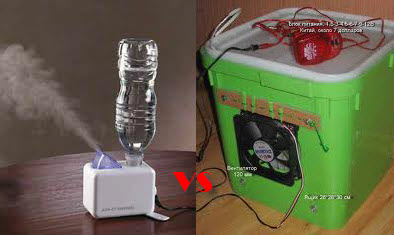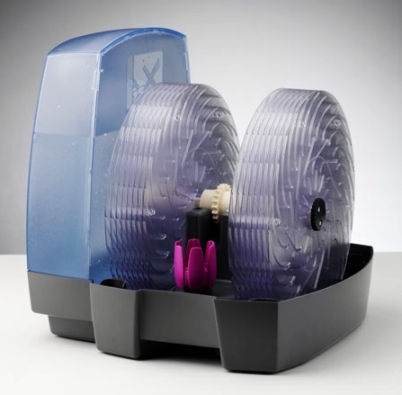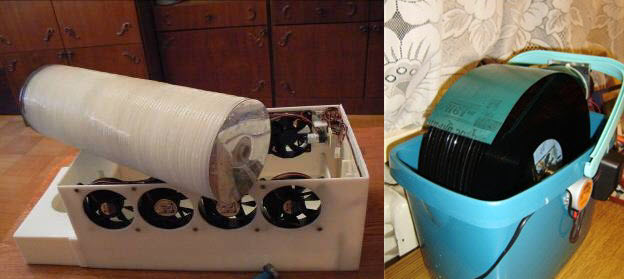Humidifier: buy or make? Difficulties of choice
Winter came, the heating season and the issue of humidifying the air again (“If the outside air is much colder than the comfort one, it is heated, which leads to a decrease in the relative humidity of the air. This is because heating increases the temperature but does not increase the amount of moisture in the air”). 
The pediatrician also said that the child will hurt less if the humidity is maintained at normal levels (“Overdrying the air causes increased evaporation of moisture from everywhere: from the skin and from the human body and domestic animals, indoor plants, from the wall covering, furniture, musical instruments, parquet, books, paintings and other objects made of absorbent materials that harm the health of inhabitants and the preservation of objects. ").
Here is a promotional video confirms this
The only problem is that there is no optimal way to moisturize - everyone has serious drawbacks and obvious advantages. And the installation of the aquarium house is not included in the plans.
Review of existing approaches, as well as DIY constructions under the cut. I hope someone will help make their choice, and who has already done - will share their impressions with the community.
Commercially available humidifiers differ in the method of evaporation, the serviced area of the room (evaporation intensity), additional functions (purification, ionization, aromatization) and other less important parameters.
Steam humidifiers are similar in principle to electric kettles. For intensive evaporation, the water in them is portionwise heated to boiling. Steam humidifiers must necessarily have a hygrostat (air humidity sensor) that turns off the device when it reaches the specified humidity, otherwise the humidity in the room can significantly exceed the optimum level. With the help of steam humidifiers, you can raise the humidity in the room to a state of saturated steam and beyond that which in turn will lead to the formation of mist (suspended condensation in air) and dew (condensed water on solid surfaces). The fog and dew from the steam humidifier actually consists of distilled water, since they were formed from steam, therefore, when the relative humidity of the air in the room decreases, such condensate evaporates without residue.
Capacity can be 7-16 liters per day with a power consumption of 300-600 W
The cost of most models on the market is around $ 80.
Ultrasonic humidifiers - are considered the most effective of the existing air humidifiers. Such humidifiers create fog, knocking out the smallest droplets of water from the surface of the water using ultrasonic vibrations generated by a piezoelectric radiator. Fog spreads over the volume of the room by natural currents of air or forcibly (for example, with the help of fans). After some time (depending on the relative humidity of the air in the room), the mist particles in the process of natural evaporation turn into steam, which leads to an increase in the relative humidity of the air. Some mist may settle on hard surfaces before evaporation. Since the fog particles were mechanically obtained from the water in the humidifier, they contain everything that was contained in the water of the working volume of the humidifier - hardness salts, microorganisms, etc. After the evaporation of the mist, everything that was dissolved or suspended in its water component becomes a dry residue. Therefore, you need to use only distilled water.
Typical performance ultrasonic humidifiers - 7-12 liters per day. Power consumption - 40-50 W (in the presence of the element for heating water, the power may exceed 125 W).
The most popular humidifiers at the moment, offers on the market range from $ 20 to $ 300.
However, if you do not use distilled water (20 liters in Moscow will cost from 150 rubles, in Kiev - from 30 hryvnia) all surfaces in the house will be covered with white salt bloom.


')
The moisturizing element is a drum of hydrophilic disks that slowly rotates around a horizontal axis. Below the axis of rotation, the disks are immersed in water and become wet, and above, they are blown by the air flow created by the fan and dry up, moistening the air.

If there are dust particles in the air flow, they with some probability stick to the wet surface of the disk and are washed away when the disk segment is immersed in the water of the humidifier's working volume. Thus, the air flow coming out of the humidifier is cleaner and more humid than the incoming air.
To fill the "air wash" you can use water from the tap, the quality requirement is one: the water should not have an undesirable smell.
The performance of cold humidifiers - 3.5-17.5 liters per day. Power consumption - 3-60 watts.
This type of humidifier, probably, would be the most optimal - if it were not for one thing: with a ridiculous simplicity of design cheap air washers do not exist in principle - the cost ranges from $ 200 to $ 1000.
Perhaps the main advantage of homemade humidifiers is the pleasure of the work done and the low cost of the product. The most original homemade humidifiers found on the Internet:
This option is the simplest, but also the lowest-performing - according to reviews per day evaporates up to 0.5 liters. In addition, the rate of evaporation is highly dependent on the battery temperature, humidity in the room and the area of evaporation.

The use of wet towels is fraught with battery corrosion and the need to repaint.
These constructions are united by an increase in the evaporation area (due to the use of gauze, rags, paper towels, etc.) and the widespread use of computer fans. As a container, people use buckets, containers for laundry and even chipboard boxes. Water-evaporating gauzes need to be changed frequently, because contaminated by settling dust, then the water begins to bloom and "smell". According to reviews, such units can evaporate several liters per day, which is clearly not enough to fully moisturize, but at least something.

Here, people are mainly experimenting with compact discs, less often with gramophone records. One of the main discussion points is the IXBT forum: http://forum.ixbt.com/post.cgi?id=print:64:2746

Such constructions are the most productive of DIY constructions, however, higher labor costs, worse aesthetics and noise quality (water overflow is heard).
If you already use a humidifier - share your experience in the comments. I also have to make a choice in favor of a decision.

The pediatrician also said that the child will hurt less if the humidity is maintained at normal levels (“Overdrying the air causes increased evaporation of moisture from everywhere: from the skin and from the human body and domestic animals, indoor plants, from the wall covering, furniture, musical instruments, parquet, books, paintings and other objects made of absorbent materials that harm the health of inhabitants and the preservation of objects. ").
Here is a promotional video confirms this
spoiler
The only problem is that there is no optimal way to moisturize - everyone has serious drawbacks and obvious advantages. And the installation of the aquarium house is not included in the plans.
Review of existing approaches, as well as DIY constructions under the cut. I hope someone will help make their choice, and who has already done - will share their impressions with the community.
Commercially available humidifiers differ in the method of evaporation, the serviced area of the room (evaporation intensity), additional functions (purification, ionization, aromatization) and other less important parameters.
Steam humidifier ("hot evaporation")
Steam humidifiers are similar in principle to electric kettles. For intensive evaporation, the water in them is portionwise heated to boiling. Steam humidifiers must necessarily have a hygrostat (air humidity sensor) that turns off the device when it reaches the specified humidity, otherwise the humidity in the room can significantly exceed the optimum level. With the help of steam humidifiers, you can raise the humidity in the room to a state of saturated steam and beyond that which in turn will lead to the formation of mist (suspended condensation in air) and dew (condensed water on solid surfaces). The fog and dew from the steam humidifier actually consists of distilled water, since they were formed from steam, therefore, when the relative humidity of the air in the room decreases, such condensate evaporates without residue.
Capacity can be 7-16 liters per day with a power consumption of 300-600 W
The cost of most models on the market is around $ 80.
Ultrasonic humidifier
Ultrasonic humidifiers - are considered the most effective of the existing air humidifiers. Such humidifiers create fog, knocking out the smallest droplets of water from the surface of the water using ultrasonic vibrations generated by a piezoelectric radiator. Fog spreads over the volume of the room by natural currents of air or forcibly (for example, with the help of fans). After some time (depending on the relative humidity of the air in the room), the mist particles in the process of natural evaporation turn into steam, which leads to an increase in the relative humidity of the air. Some mist may settle on hard surfaces before evaporation. Since the fog particles were mechanically obtained from the water in the humidifier, they contain everything that was contained in the water of the working volume of the humidifier - hardness salts, microorganisms, etc. After the evaporation of the mist, everything that was dissolved or suspended in its water component becomes a dry residue. Therefore, you need to use only distilled water.
Typical performance ultrasonic humidifiers - 7-12 liters per day. Power consumption - 40-50 W (in the presence of the element for heating water, the power may exceed 125 W).
The most popular humidifiers at the moment, offers on the market range from $ 20 to $ 300.
However, if you do not use distilled water (20 liters in Moscow will cost from 150 rubles, in Kiev - from 30 hryvnia) all surfaces in the house will be covered with white salt bloom.


')
Air washing (also known as “traditional”, “cold evaporation”)
The moisturizing element is a drum of hydrophilic disks that slowly rotates around a horizontal axis. Below the axis of rotation, the disks are immersed in water and become wet, and above, they are blown by the air flow created by the fan and dry up, moistening the air.

If there are dust particles in the air flow, they with some probability stick to the wet surface of the disk and are washed away when the disk segment is immersed in the water of the humidifier's working volume. Thus, the air flow coming out of the humidifier is cleaner and more humid than the incoming air.
To fill the "air wash" you can use water from the tap, the quality requirement is one: the water should not have an undesirable smell.
The performance of cold humidifiers - 3.5-17.5 liters per day. Power consumption - 3-60 watts.
This type of humidifier, probably, would be the most optimal - if it were not for one thing: with a ridiculous simplicity of design cheap air washers do not exist in principle - the cost ranges from $ 200 to $ 1000.
Summary table of advantages and disadvantages
| Humidifier type | Benefits | disadvantages |
|---|---|---|
| Steam | High humidification performance; Water, evaporating, is cleared of nonvolatile impurities; Simplicity of service - does not demand raskhodnik. | High power consumption; Increase the air temperature in the room. |
| Ultrasonic | Accurate moisture control if equipped with a hygrostat; High humidification performance; The temperature of the outgoing steam is practically room temperature; Low noise. | Expensive maintenance - the mandatory use of distilled water or special water filters (reverse osmosis filter saves the situation); The need for frequent addition of water, since the capacity of these humidifiers is limited; In the absence of a hygrostat in the device, it is very easy to re-moisten the air, which leads to the effect of a bath: objects, linen, clothes become wet. |
| Cold evaporation | Low power consumption; Do not overwet the air; Simultaneous cleaning and moistening; Do not require consumables (except tap water); Safe for children. | Relatively large size devices; The need for frequent maintenance of work surfaces - to clean the plaque and change the water; High price. |
Existing do-it-yourself approaches
Perhaps the main advantage of homemade humidifiers is the pleasure of the work done and the low cost of the product. The most original homemade humidifiers found on the Internet:
Use of central heating battery
This option is the simplest, but also the lowest-performing - according to reviews per day evaporates up to 0.5 liters. In addition, the rate of evaporation is highly dependent on the battery temperature, humidity in the room and the area of evaporation.

The use of wet towels is fraught with battery corrosion and the need to repaint.
Cold evaporation constructions
These constructions are united by an increase in the evaporation area (due to the use of gauze, rags, paper towels, etc.) and the widespread use of computer fans. As a container, people use buckets, containers for laundry and even chipboard boxes. Water-evaporating gauzes need to be changed frequently, because contaminated by settling dust, then the water begins to bloom and "smell". According to reviews, such units can evaporate several liters per day, which is clearly not enough to fully moisturize, but at least something.

Homemade air wash
Here, people are mainly experimenting with compact discs, less often with gramophone records. One of the main discussion points is the IXBT forum: http://forum.ixbt.com/post.cgi?id=print:64:2746

Such constructions are the most productive of DIY constructions, however, higher labor costs, worse aesthetics and noise quality (water overflow is heard).
If you already use a humidifier - share your experience in the comments. I also have to make a choice in favor of a decision.
Materials used in the preparation of the article
http://ru.wikipedia.org/wiki/Humidifier ,
http://forum.ixbt.com/post.cgi?id=print:64:2746
Sites with reviews about the technology http://irecommend.ru/category/konditsionery?tid=77028 ,
http://otzovik.com/?search_text=Humidifier+air&x=0&y=0
Online product catalogs http://market.yandex.ua/guru.xml?CMD=-RR=0,0,0,0-VIS=70-CAT_ID=119471-EXF=1-EXC=1-PG=10&hid = 734595 ,
http://hotline.ua/bt/uvlazhniteli-ochistiteli-vozduha/
http://forum.ixbt.com/post.cgi?id=print:64:2746
Sites with reviews about the technology http://irecommend.ru/category/konditsionery?tid=77028 ,
http://otzovik.com/?search_text=Humidifier+air&x=0&y=0
Online product catalogs http://market.yandex.ua/guru.xml?CMD=-RR=0,0,0,0-VIS=70-CAT_ID=119471-EXF=1-EXC=1-PG=10&hid = 734595 ,
http://hotline.ua/bt/uvlazhniteli-ochistiteli-vozduha/
Source: https://habr.com/ru/post/161001/
All Articles